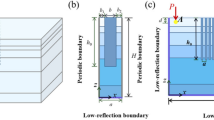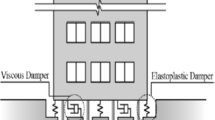Abstract
Earthquakes have caused colossal casualties and severe damages to engineering structures and especially leading to substantial economic loss to the underground structures and/or infrastructures. Pipelines are one of most important component of lifeline engineering. For instance, the Southern Caucasus- Eastern Turkey energy corridors are formed by several key pipelines carrying crude oil and natural gas from Azerbaijan, via Georgia, to world markets through Mediterranean Sea. Many project accomplished recently and construction of new corridors are still going on. They should be protected from earthquake disaster especially when they pass through high seismicity zones. The installation of wave impeding barriers (WIB) below the vulnerable infrastructures as pipelines established in soft soil can be used to reduce the effect of the earthquake induced ground borne vibrations. In this paper, a WIB as artificial bedrock based on the cut-off frequency of a soil layer over bedrock is proposed as isolation measurement in order to mitigate the dynamic response of the buried pipelines under earthquake strong ground motion. The computational simulation of the wave propagation problem is directly achieved by employing nonlinear 2D finite element modelling for prediction of screening performance of WIB on the dynamic response of vibrating coupled soil-pipeline system. Energy absorbing boundaries along the truncated interfaces of the unbounded nature of the underlying soil media are implemented in the time domain along with Newmark’s integration. An extensive parametric investigation and systematic computations are performed with different controlling parameters. The obtained numerical results point out that WIB can be very promising as an isolator to protect pipelines when they establish for a certain depth.











Similar content being viewed by others
References
Adam M and Chouw N 2001 Reduction of footing response to man-made excitations by using a wave impeding barrier. J. Appl. Mechanics 4: 423–431
Adam M and Estorff O Von 2005 Reduction of train-induced building vibrations by using open and filled trenches. Computers and Structures 83: 11–24
Ahmad S and Al-Hussaini T M 1991 Simplified design for vibration screening by open and infilled trenches. J. Geotechnical Eng. 117(1): 67–88
Beskos D E, Dasgupta G and Vardoulakis I G 1986 Vibration isolation using open or filled trenches part 1: 2-D homogeneous soil. Computational Mechanics 1(1): 43–63
Brinkgreve R B J, Al-Khoury R, Bakker K J, Bonnier P G, Brand P J W, Broere W, Burd H J, Soltys G, Vermeer P A and Haag D D 2002 Plaxis finite element code for soil and rock analyses, Published and distributed by A A Balkema Publisher, The Netherlands
Celebi E, Fırat S and Cankaya I 2006 The effectiveness of wave barriers on the dynamic stiffness coefficients of foundations using boundary element method. Appl. Mathematics and Computation 180: 683–699
Celebi E, Fırat S, Beyhan G, Çankaya I, Vural I and Kírtel O 2009 Field experiments on wave propagations and vibration isolation by using wave barriers. Soil Dynamics and Earthquake Eng. 29: 824–833
Celebi E and Goktepe F 2012 Non-linear 2-D FE analysis for the assessment of isolation performance of wave impeding barrier in reduction of railway-induced surface waves. Construction and Building Materials 36(2012): 1–13
Celebi E, Goktepe F and Kirtel O 2011 Vibration isolation measures for reductions of structural responses due passage of high-speed trains. Eurodyn 2011, Leuven, Belgium
Chouw N and Schmid G 1999 Numerical and experimental investigation on wave impediment in soil. Structural dynamics EURODYN’99, Fryba & Naprstek, Balkema, Roterdam, pp. 977–982
Courant R, Friedrichs K and Lewy H 1967 On the Partial Difference Equations of Mathematical Physics. IBM J. 11:215–234
Da Ha, Abdoun T H, O’Rourke M J, Symans M D, O’Rourke T D, Palmer M C and Stewart H E 2010 Earthquake Faulting Effects on Buried Pipelines-Case History and Centrifuge Study. J. Earthquake Eng. 14(5):646–669
Daiyan N, Kenny S, Phillips R and Popescu R 2011a Numerical investigation of axial-vertical and lateral-vertical pipeline/soil interaction in sand. Pan-Am CGS, Geotechnical Conference, Toronto, Ontario, Canada
Daiyan N, Kenny S, Phillips R and Popescu R 2011b Investigating pipeline-soil interaction under axial-lateral relative movements in sand. Canadian Geotechnical J. 48(11): 1683–1695
Forchap E and Verbic B 1994 Wave propagation and reduction of foundation vibrations. Berg-Verlag GmbH, Bochum, pp. 165–178
Gamber N K 2004 Shallow foundation systems response to blast loading. A Thesis Presented to The Faculty of the Fritz J and Dolores H Russ College of Engineering and Technology, Ohio University, In Partial Fulfillment Of the Requirement for the Degree Master of Science, Athens
Goktepe F, Kirtel O and Celebi E 2010 Wave impeding block for mitigation of structural responses to train induced vibrations. 9th International Congress on Advances in Civil Engineering, Karadeniz Technical University, Trabzon, Turkey
Goktepe F, Kuyuk H S and Celebi E 2011a Efficiency of wave impeding barrier in pipeline construction under earthquake excitation using finite element analysis. International Conference on Earthquake Engineering and Seismology (ICEES: 2011), NUST, Islamabad, Pakistan
Goktepe F, Kuyuk H S and Celebi E 2011b Investigation on Wave Impending Barrier Thickness In Frequency Domain. Sixth International Conference of Seismology and Earthquake Engineering (SEE6), Tehran, Iran
Goktepe F, Kuyuk H S and Celebi E 2011c Efficiency of Wave Impeding Barrier for Wave Propagation In Pipeline under Earthquake Excitation. Seventh National Conference on Earthquake Engineering, Istanbul, Turkey (in Turkish)
Guo P 2005 Numerical Modeling of Pipe-Soil Interaction under Oblique Loading. J. Geotechnical and Geoenvironmental Eng. 131(2): 260–268
Hall W J and O’Rourke T D 1991 Seismic behavior and vulnerability of pipelines. Lifeline earthquake engineering Cassaro M A, (ed.) American Society of Civil Engineers, New York, pp. 761–773
Haupt W A 1981 Model tests on screening of surface waves. In: Proceedings of the 10th International Conference on Soil Mech. Found. Eng. Stockholm, Sweden, 3, pp. 215–222
Hughes T J R 1987 The finite element method. Prentice-Hall
Klein R, Antes H and Houedec D Le 1997 Efficient 3D modelling of vibration isolation by open trenches. Computers & Structures 64(1–4): 809–817
Kouretzis G P, Bouckovalas G D and Gantes C J 2006 3-D shell analysis of cylindrical underground structures under seismic shear (S) wave action. Soil Dynamics and Earthquake Eng. 26(10): 909–921
Kouretzis G P, Sloan S W and Carter J P 2013 Effect of interface friction on tunnel liner internal forces due to seismic S- and P-wave propagation. Soil Dynamics and Earthquake Eng. 46: 41–51
Leung K L, Vardoulakis I G, Beskos DE and Tassoulas J L 1991 Vibration isolation by trenches in continuously non-homogenous soil by the BEM. Soil Dynamics and Earthquake Eng. 10(3): 172–179
Liu H and Song E 2005 Seismic response of large underground structures in liquefiable soils subjected to horizontal and vertical earthquake excitations. Computers and Geotechnics 32(4):223–244
Pflanz G, Hashimoto K and Chouw N 2002 Reduction of structural vibrations induced by a moving load. J. Appl. Mechanics 5: 555–563
Smith I M and Griffith D V 1982 Programming the Finite Element Method. Second Edition, John Wiley & Sons, Chisester, UK
Takemiya H 1998a Lineside ground vibrations induced by high-speed train passage. Workshop on Effect of High-Speed Vibration on Structures and Equipment, Dept. Civil Eng., Nat. Cheng Kung Univ., Tainan, Taiwan, R.O.C., pp. 43–49
Takemiya H 1998b Paraseismic behavior of wave impeding block measured for ground vibration reduction. Workshop on Effect of High-Speed Vibration on Structures and Equipment, Dept. Civil Eng., Nat. Cheng Kung Univ., Tainan, Taiwan, R.O.C., pp. 51–56
Trifonov O V and Cherniy V P 2010 A semi-analytical approach to a nonlinear stress–strain analysis of buried steel pipelines crossing active faults. Soil Dynamics and Earthquake Eng. 30(10): 1298–1308
Woods R D (1968) Screening of surface waves in soils. J. Soil Mechanics and Foundations Division ASCE 94(4): 951–979
Zaneta G Adme 2006 Analysis NATM tunnel responses due to earthquake loading in various soils. Mining Technology Bulletin-Institute of Mining Science and Technology 2(3): 9–17
Zienkiewicz O and Taylor R 1991 The finite element method, 4th Edition. Vol 1, 2. McGraw-Hill, London
Author information
Authors and Affiliations
Corresponding author
Rights and permissions
About this article
Cite this article
GOKTEPE, F., KUYUK, H.S. & CELEBI, E. Efficiency of wave impeding barrier in pipeline construction under earthquake excitation using nonlinear finite element analysis. Sadhana 39, 419–436 (2014). https://doi.org/10.1007/s12046-014-0227-8
Received:
Revised:
Accepted:
Published:
Issue Date:
DOI: https://doi.org/10.1007/s12046-014-0227-8




